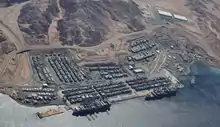Port of Aqaba
The Port of Aqaba is the only port in Jordan, and is owned by Aqaba Development Corporation (ADC) and has 12 terminals operated by five operators:the Aqaba Company for port management and operation ; Aqaba Container Terminal; Industrial Port Company; phosphate Company; National Electricity power Company, and the pilotage operated by Aqaba port Marine Services Company .
| Port of Aqaba | |
|---|---|
 The Port of Aqaba | |
| Location | |
| Country | Aqaba, Jordan |
| Coordinates | 29.5167°N 35°E |
| UN/LOCODE | JOAQJ[1] |
| Details | |
| Owned by | Aqaba Development Corporation |
| Statistics | |
| Annual cargo tonnage | 20 million tons |
| Website http://www.adc.jo | |
History
Aqaba has been a major port since the Iron Age. The Bible refers to the area in (1 Kings 9:26): "King Solomon also built ships in Ezion-Geber, which is near Eloth in Edom, on the shores of the Red Sea," in which Eloth refers to a port on the grounds of Aqaba. The Aqaba port was particularly important after the Ottomans built the Hejaz railway, which connects the port to Damascus and Medina. Today, the economy of Aqaba is largely based around the port sector. Recently, an Abu Dhabi consortium of companies called Al Maabar has won the bid to relocate and manage the Aqaba port for 30 years and expand the existing ferry terminal which receives about 1.3 million passengers and thousands of trucks and cars coming from across the shore in Egypt.[2]
Relocation
In 2006, the port was relocated from the city's centre to its south, due to a deeper water level there. Another relocation is also scheduled; it would place the port near the southernmost part of the province near the Saudi Arabian border.[3] Its capacity will surpass that of the current port. The project will cost US$5 billion, and it will be completed by 2014.[3]
Aqaba container terminal

The port contains the Aqaba container terminal (ACT), Jordan's only container port, and the second-busiest facility on the Red Sea by container volume. The ACT is a logistics hub and an important part of the Jordanian economy.[4] It is the primary gateway for the Jordanian market, and a crucial transit point for cargo moving between countries in the region.
The ACT is a joint venture between Aqaba Development Corporation and APM Terminals under a 25-year build-operate-transfer agreement that was signed in 2006.[5][6] A terminal expansion project completed in October 2013 added 460 metres (1,510 feet) to the existing quay to create a total quay length of one-kilometre (0.62-mile), increasing the annual container throughput capacity to 1.3 million TEUs. The expansion program, begun in 2009, has included the delivery of two new ship-to-shore cranes with a 22 container row reach, and four rubber tyred gantry cranes.[7][8][9]
In 2004, the Aqaba Development Corporation (ADC), on behalf of the Aqaba Special Economic Zone Authority (ASEZA), acquired and took over the management and operation of the terminal. In 2006, a 25-year Joint Development Agreement (JDA) was signed between ADC and ACT. Under this contract, APM Terminals Jordan is responsible for operating, managing and marketing ACT.[10]
References
- "UNLOCODE (JO) - JORDAN". service.unece.org. Retrieved 28 April 2020.
- "Aqaba Ports Corporation". Archived from the original on 28 April 2012. Retrieved 11 April 2013.
- "ARCADIS manages new port for Aqaba". ARCADIS. 21 March 2013. Archived from the original on 30 October 2014. Retrieved 14 July 2013.
- "Aqaba Container Terminal's CEO Jeppe Jensen harboring ambitions". Cite journal requires
|journal=(help) - "Aqaba Container Terminal Logistics of the Levant". Cite journal requires
|journal=(help) - "Aqaba Container Terminal a public private partnership model". Cite journal requires
|journal=(help) - "Aqaba Container Terminal Celebrates 2012 advancements". Cite journal requires
|journal=(help) - "Aqaba Container Terminal completes first phase of berth expansion". Cite journal requires
|journal=(help) - "Aqaba Container Terminal Expansion is officially opened". Cite journal requires
|journal=(help) - "Aqaba's port complex undergoing redevelopment and expansion". Cite journal requires
|journal=(help)